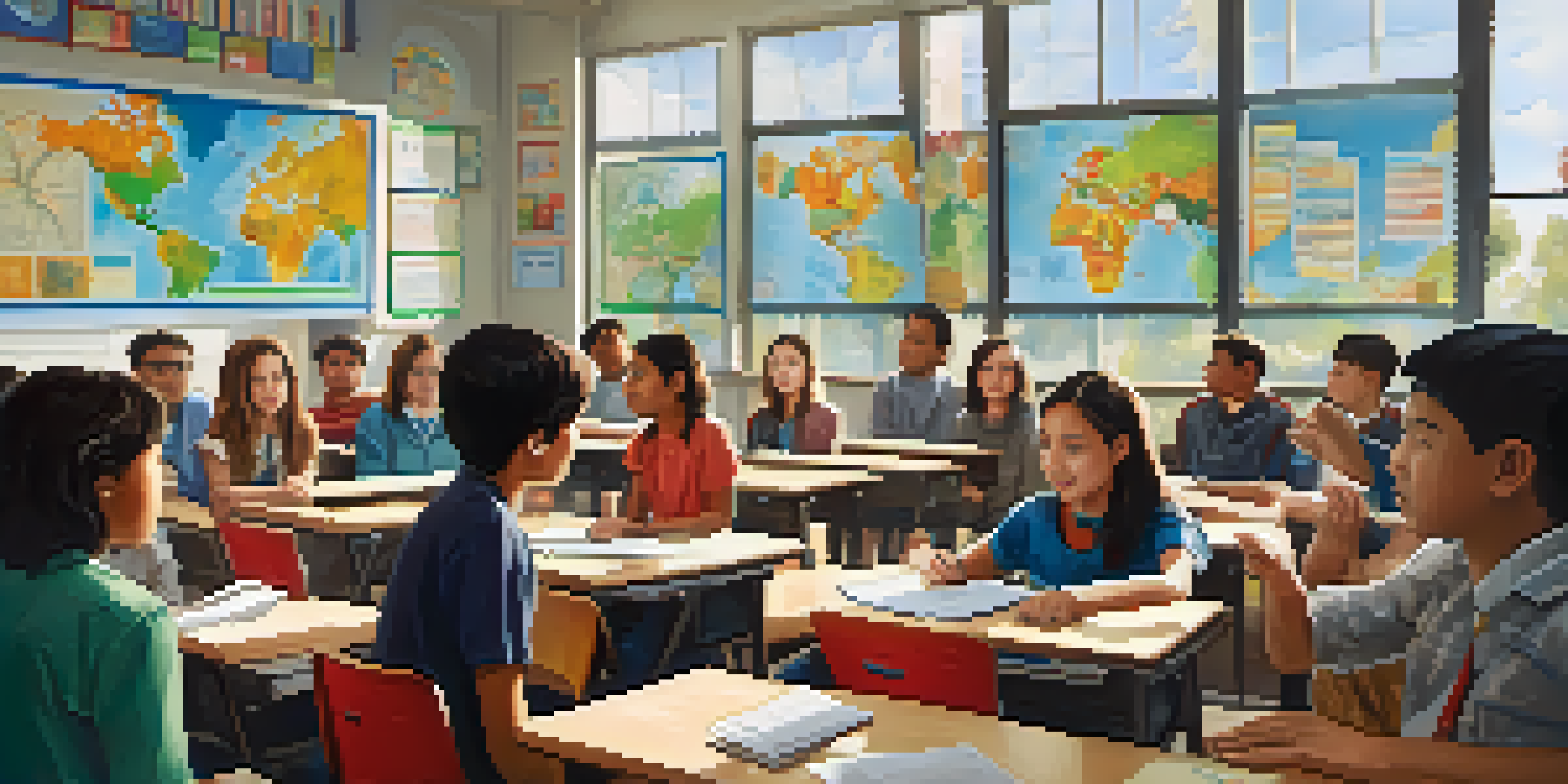Strategies for Teaching About Global Conflicts in Classrooms

Incorporating Current Events into Classroom Discussions
Bringing current events into the classroom can spark meaningful discussions about global conflicts. By analyzing news articles or reports, students will see the relevance of these conflicts to their lives. This approach not only keeps the content fresh but also encourages critical thinking and engagement.
Education is the most powerful weapon which you can use to change the world.
For instance, discussing a recent peace treaty or an ongoing conflict allows students to connect theory to real-world implications. They can debate the effectiveness of various approaches and consider different perspectives. This method fosters an environment where students feel empowered to express their views and learn from each other.
Additionally, using multimedia resources such as videos or podcasts can enhance the learning experience. These tools can provide various viewpoints and narratives that deepen students' understanding of complex issues. By diversifying the materials, educators can cater to different learning styles and keep students interested.
Utilizing Interactive Activities to Engage Students
Interactive activities, such as role-playing or simulations, can make learning about global conflicts dynamic and engaging. By putting students in the shoes of different stakeholders, they can better grasp the complexities of each situation. This hands-on approach encourages empathy and a deeper understanding of the issues at hand.

For example, a mock United Nations debate can help students articulate their positions on global issues while learning about diplomacy and negotiation. This experience not only builds their public speaking skills but also fosters teamwork and collaboration. As they navigate differing viewpoints, they learn the importance of compromise and critical dialogue.
Engaging with Current Events
Incorporating current events into classroom discussions fosters critical thinking and relevance to students' lives.
Moreover, incorporating technology through online platforms for simulations can further enhance the experience. Students can engage with peers from different backgrounds, fostering a global perspective. This connection can lead to richer discussions and a more profound understanding of the interconnectedness of global issues.
Encouraging Critical Thinking through Debates
Debates are a powerful tool for developing critical thinking skills in students while exploring global conflicts. By taking on various perspectives, students learn to analyze arguments, evaluate evidence, and articulate their thoughts clearly. This skill not only applies to the classroom but also equips them for real-world discussions.
The only thing necessary for the triumph of evil is for good men to do nothing.
When organizing a debate, it’s essential to provide students with a framework for research and argumentation. This might include guidelines on how to gather credible sources and construct logical arguments. With proper guidance, students can feel confident in defending their positions while remaining open to counterarguments.
Furthermore, debates can illuminate the nuances of conflict, revealing that there are rarely clear-cut answers. This realization encourages students to appreciate the complexity of global issues and develop a more nuanced worldview. Ultimately, this process fosters a respectful environment where diverse opinions can coexist.
Integrating Literature and Media for Deeper Insights
Literature and media serve as powerful tools for exploring global conflicts from different angles. Novels, documentaries, and films can humanize the experiences of those affected by conflict, providing students with emotional connections to the material. This engagement can lead to meaningful discussions about the impact of war and peace on individuals and communities.
For instance, reading a novel set in a conflict zone can prompt students to discuss the broader implications of the narrative. They can analyze the characters' decisions and the societal factors at play, fostering critical insights into the complexities of conflict. This literary approach encourages empathy and deeper comprehension of the human side of global issues.
Promoting Empathy through Activities
Interactive activities, such as role-playing, help students understand global conflicts by encouraging empathy and collaboration.
Incorporating various media formats also caters to diverse learning preferences, ensuring that all students can engage with the content. Visual and auditory learners may find documentaries particularly impactful, while others might connect more with written narratives. By providing a mix of resources, educators can create a richer learning experience.
Promoting Global Citizenship through Service Learning
Service learning projects can foster a sense of global citizenship among students while addressing issues related to global conflicts. By engaging in community service or advocacy, students can take an active role in contributing to solutions. This hands-on approach helps them understand their responsibilities as global citizens.
For example, students might participate in a project that raises awareness about a specific conflict or supports refugees in their community. This not only educates them about the issues but also empowers them to make a difference. As they see the impact of their efforts, they develop a sense of agency and responsibility.
Moreover, these projects often encourage collaboration with local and international organizations, broadening students' perspectives. They learn about the interconnectedness of their community with global issues, reinforcing the idea that local actions can have far-reaching effects. This experience ultimately cultivates empathy and a commitment to social justice.
Fostering Open Dialogue and Safe Spaces in Classrooms
Creating an open dialogue in the classroom is essential for discussing sensitive topics like global conflicts. Establishing a safe space where students feel comfortable sharing their thoughts encourages honesty and respect. This environment allows for a richer exploration of diverse perspectives and fosters mutual understanding.
Teachers can start by setting ground rules for discussions, emphasizing the importance of listening and respecting differing opinions. This foundation enables students to engage in meaningful conversations without fear of judgment. When students feel safe, they are more likely to express their thoughts candidly, leading to deeper insights.
Linking History to Modern Issues
Connecting historical events to present-day conflicts enhances students' understanding of global issues and encourages proactive thinking.
Additionally, incorporating reflective practices, such as journaling or group discussions, can help students process their feelings about the topics discussed. This reflection allows them to connect personal experiences with global issues, reinforcing the relevance of the material. Ultimately, fostering open dialogue nurtures a culture of empathy and respect in the classroom.
Connecting History to Present-Day Conflicts
Linking historical events to current conflicts can provide students with valuable context and understanding. By studying the roots of a conflict, they can grasp how past decisions and actions shape present-day realities. This historical perspective enriches their analysis and helps them appreciate the complexities of global issues.
For example, examining the causes of World War I can lead to discussions about its lasting impact on contemporary geopolitics. Students can analyze how alliances, treaties, and national interests continue to influence today's world. This connection fosters critical thinking and helps students see the relevance of history in understanding current events.

Furthermore, drawing parallels between historical and modern conflicts can inspire students to consider potential solutions. They can explore lessons learned from the past and apply them to contemporary issues. This approach not only deepens their understanding but also encourages proactive thinking about how to address global challenges.